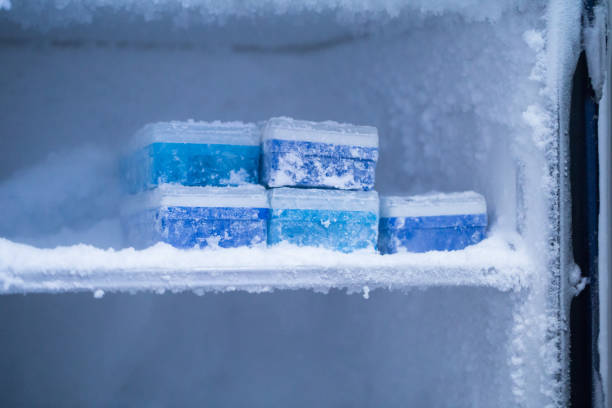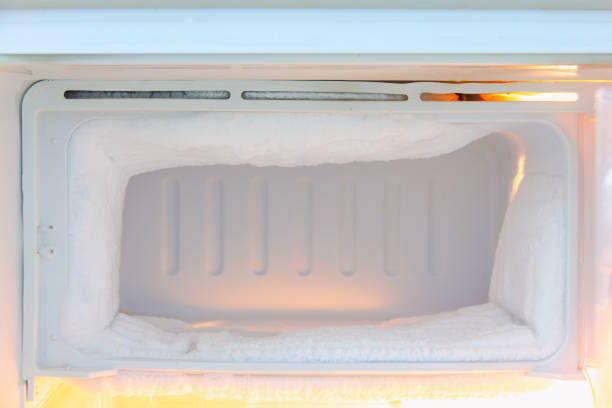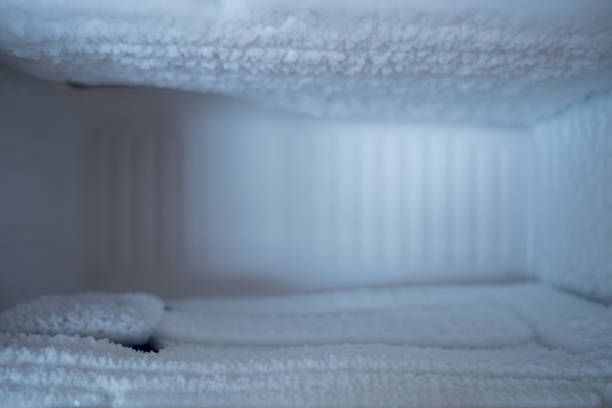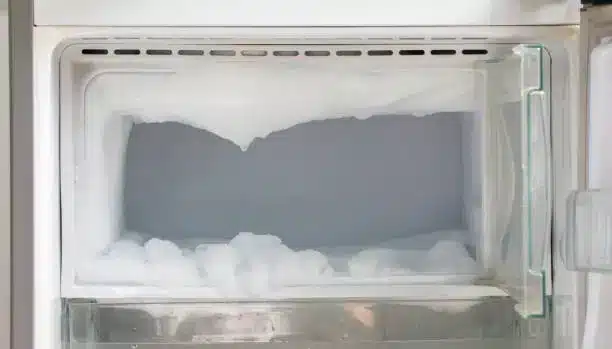Ice buildup in your freezer is not only annoying, but also wasteful. It takes up valuable space, reduces the efficiency of your freezer, and makes your food harder to access. Ice buildup can also affect the quality and safety of your food, causing freezer burn, spoilage, or contamination. If you’re tired of scraping off ice from your freezer walls or dealing with frosty packages, here are some tips on how to prevent and remove ice buildup in your freezer.
To prevent ice buildup in your freezer, you need to keep the temperature at 0°F (-18°C) or below, avoid opening the door too often or for too long, check the door seal and gasket for any damage or gaps, only put cooled food in the freezer and do not overload it, and clean your freezer regularly. To remove ice buildup in your freezer, you can scrape it off with a plastic spatula or a heated cloth, use a freezer frost remover spray, or defrost the freezer by unplugging it and letting the ice melt.
How Ice Buildup Occurs in Your Freezer
Ice buildup occurs when warm or humid air comes into contact with the cold surfaces of your freezer. This can happen for several reasons, such as:
- Opening the door too often or for too long. This lets warm air enter and cold air escape from your freezer, creating condensation and frost.
- Putting hot or warm food in the freezer. This raises the temperature and humidity inside your freezer, causing more moisture to freeze on the walls and packages.
- Having a faulty door seal or gasket. This allows warm air to leak into your freezer and cold air to leak out, creating an ideal environment for ice formation.
- Overloading your freezer. This prevents proper air circulation and temperature distribution inside your freezer, leading to uneven cooling and freezing.
- Having a dirty or clogged defrost drain or condenser coils. This affects the performance and efficiency of your freezer, making it work harder and produce more frost.

How to Prevent Ice Buildup in Your Freezer
The best way to prevent ice buildup in your freezer is to avoid the conditions that cause it in the first place. Here are some steps you can take to keep your freezer frost-free:
- Keep the temperature at 0°F (-18°C) or below. This is the optimal temperature for food safety and quality, as well as for preventing ice formation. You can use a thermometer to check the temperature of your freezer and adjust it if needed.
- Avoid opening the door too often or for too long. This will help maintain a constant temperature and humidity inside your freezer and prevent warm air from entering. Try to plan ahead what you need from your freezer and open it only when necessary.
- Check the door seal and gasket for any damage or gaps. The door seal and gasket are the rubber parts that create an airtight seal between the door and the freezer. If they are worn out, torn, or loose, they can let warm air in and cold air out of your freezer. You can test them by closing the door on a dollar bill and trying to pull it out. If it slides out easily, you need to replace the seal or gasket.
- Only put cooled food in the freezer and do not overload it. Wait for hot or warm food to cool down completely before putting it in the freezer. This will prevent excess moisture from freezing on the walls and packages. Also, do not fill your freezer more than 75-80% full. Leave some space between the items to allow proper air circulation and temperature distribution.
- Clean your freezer regularly. Dust and dirt can accumulate on the defrost drain and the condenser coils of your freezer, affecting its performance and efficiency. You should clean them at least once a year or more often if you notice any problems. To clean the defrost drain, use a turkey baster or a pipe cleaner to flush out any debris with hot water or vinegar. To clean the condenser coils, use a vacuum cleaner or a brush to remove any dust or lint.

How to Remove Ice Buildup in Your Freezer
If you already have ice buildup in your freezer, you can try one of these methods to remove it:
- Scrape it off with a plastic spatula or a heated cloth. This is a quick and easy way to remove thin layers of ice from your freezer walls or packages. Use a plastic spatula or a wooden spoon to gently scrape off the ice. Or use a cloth dipped in hot water or rubbing alcohol to melt the ice and wipe it off.
- Use a freezer frost remover spray. This is a product that you can spray on the ice buildup to dissolve it quickly and easily. Follow the instructions on the label and make sure to wear gloves and goggles for safety.
- Defrost the freezer by unplugging it and letting the ice melt. This is the most effective but also the most time-consuming way to remove ice buildup from your freezer. You will need to empty your freezer and store your food in another freezer, a cooler, or the fridge. Then, unplug your freezer and leave the door open for several hours until all the ice melts. You can place towels or trays at the bottom of your freezer to catch the water. After the ice is gone, wipe your freezer dry and plug it back in.

FAQs About Ice Buildup in Your Freezer
Q: How often should I defrost my freezer?
A: It depends on how much ice buildup you have in your freezer. If you follow the prevention tips above, you may not need to defrost your freezer at all. However, if you notice more than 1/4 inch of ice on the walls or packages, you should defrost your freezer as soon as possible.
Q: What is a frost-free freezer?
A: A frost-free freezer is a type of freezer that has a built-in system that prevents ice buildup. It works by using a fan and a heater to circulate warm air inside the freezer and melt any frost that forms. The melted water then drains out through a tube to a pan underneath the freezer, where it evaporates. A frost-free freezer does not need manual defrosting, but it may use more energy and make more noise than a regular freezer.
Q: Can ice buildup damage my food or my freezer?
A: Yes, ice buildup can damage both your food and your freezer. Ice buildup can cause freezer burn, which is a condition that affects the quality of frozen food. It makes food dry, tough, and discolored, and reduces its flavor and nutritional value. Ice buildup can also damage your freezer by reducing its efficiency, increasing its energy consumption, and causing mechanical problems.
Conclusion
Ice buildup in your freezer is a common problem that can be prevented and removed with some simple tips. By keeping the temperature at 0°F (-18°C) or below, avoiding opening the door too often or for too long, checking the door seal and gasket for any damage or gaps, only putting cooled food in the freezer and not overloading it, and cleaning your freezer regularly, you can keep your freezer frost-free and your food fresh. If you already have ice buildup in your freezer, you can scrape it off with a plastic spatula or a heated cloth, use a freezer frost remover spray, or defrost the freezer by unplugging it and letting the ice melt.




